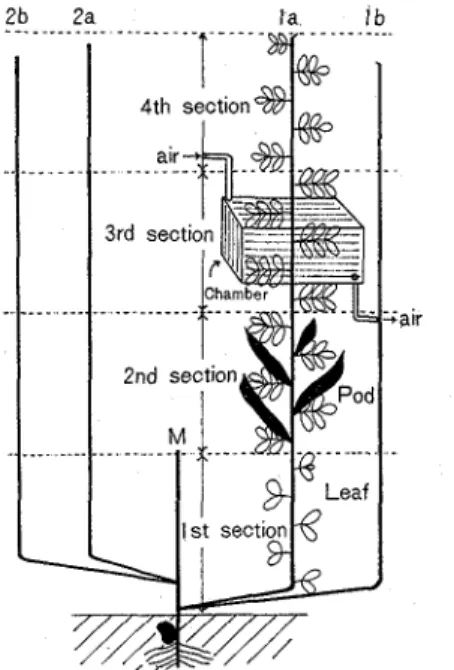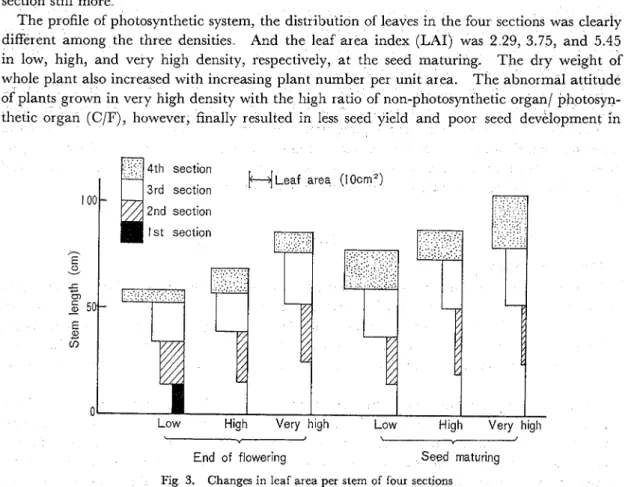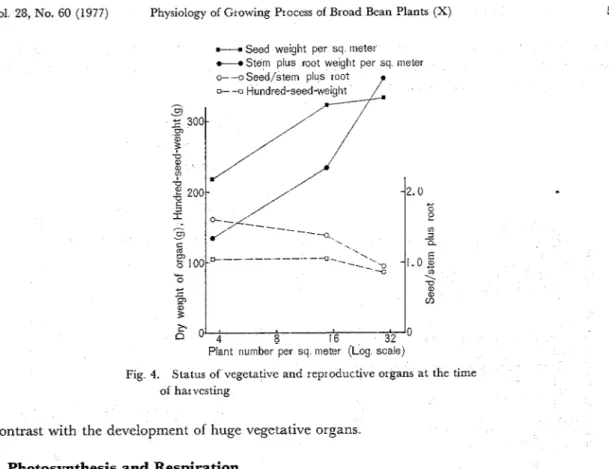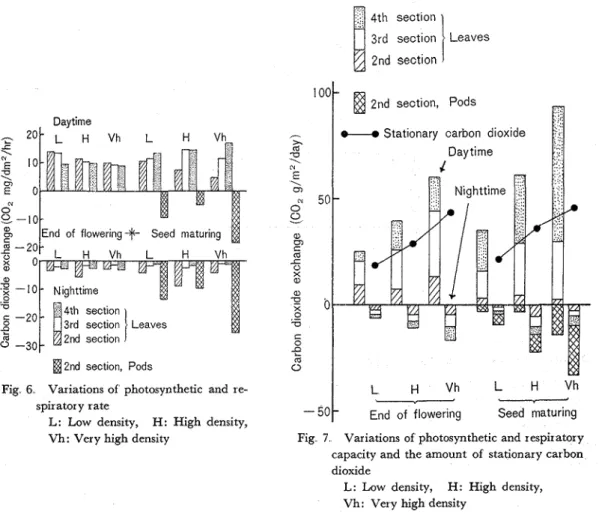Tech Bull Fac Agr. Kagawa Univ Vol. 28, No 60, 1-9, 1977 1
PHYSIOLOGICAL STUDIES O F T H E GROWING PROCESS O F BROAD BEAN PLANTS
X Effects of Plant Density on Carbon Dioxide Exchange of Leaves and Pods
Kiyoshi KOGURE (TAMAKI), Tsugumi Or01 and Junzaburo NAKA
The effects of plant density on carbon dioxide cxchange of leaves and pods were studied to obtain further assessment on the nature of the competition of broad bean plants, using the cul- tivar "Sanuki-nagasaya" as material The experiment was conducted with thrcc densities of low (3 8/m2), high (15 21m2), and ver y high (30 4/m2)
The competition began after the start of flowering. Stems elongated and leaves resulted in much mutual shading and defoliated, the higher plant density, the more early and severely With increasing plant density, however, the reproductive organlvegetative organ ratio became low and finally this fact resulted in less seed yield and poor seed development
The photosynthetic rate was accelerated in the upper section and retarded in the lower sec- tion with increasing plant density The respiratory rate of leaves in the nighttime was height- ened in the lower section especially in high density. The respiration of pods became high in the nighttimc and in very high density with the growth advanced
The daily stationary carbon dioxidc per square meter was abundant with increasing plant density, but the respiration/photosynthesis ratio was simultaneously heightened Moreover, the closely source-sink relationship was recognized between leaves of the 2nd plus 3rd section and rcproductive organs in low density The relationship of this kind, however, was not neces- sarily valid between leavcs of the upper 4th section which occupied the major part of photosyn- thetic system and pods including inner seeds in very high density, showing the reason of less seed yield and poor seed development.
Judging from the results, it may be reassessed that high density of this experiment is the opti- mum density for winter type broad bean plants in warm regions of Japan
2 Kiyoshi KOGURE (TAMAKI), Tsugumi OTOI and Junzaburo NAKA Tech. Bull. Fac, Agr. Kagawa Univ.
Introduction
As a first approach to explain the changing pattern of competition which follows from altering plant density of broad bean (Vzcia faba), detailed analyses have been made in a previous paper(l6). I t was proved that the competition of tops began after the start of flowering and the leaf area was decided a t the green pod maturing by the defoliation in the lower and upper portions. And the results confirmed that the optimum density for winter type broad bean "Sanuki-naga- saya" in warm regions of Japan was the density of 15 2 plants per square meter (high density).
O n the other hand, with regard to the physiological status of leaves and stems, there have been reported many experiments about the activity of photosynthesis and respiration(l.13,17) and the effect of leaf removaI(4~8~15). I n a previous paper(17) it was proved that the activity of photosynthesis and respiration was distinguishable by four sections based on the flowering and pod bearing habit and transmitted from lower to upper section accompanying with the growth advanced. The authors also pointed out that vegetative organs of the 2nd section, which was adjacent to pod bearing nodes, were very important for the normal growing process(l5).
The object of this investigation is supplemental to these researches about the nature of compe- tition. The present study is concerned with the effects of plant density on the difference of carbon dioxide exchange of leaves and pods and the meanings for the pfoduction and distribution
o: dry matter
Materials and Methods
Broad beans, cultivar "Sanuki-nagasaya", were sown in a field on November 6 and seedlings were grown as a plant per hill. The fertilizer application was made as basal dressing: 27 Kg ammonium suIfate, 45 Kg calcium superphosphate, and 18 Kg potassium chloride per 10 a were plowed down. The experimental design was the same as mentioned in the previous paper(l6) exclusive of medium density (Table 1 .)
.
Table 1. Experimental design
Row width Hill distance Plant number
Density cm cm per sq meter
Low 72 36 3.8
High 36 18 15.2
Very high 36 9 30.4
As for a portion measured, of primary four branches as shown in Fig. 1, la, the first branched one, was used. Three compound leaves in each section based on the flowering and pod bear- ing habit(l5) or pods in the 2nd section were pursued measuring the activity of photosynthesis
Vol. 28, No. 60 (1977) Physiology of Growing Process of Broad Bean Plants (X)
Fig 1 Explanation of branches and four sections of stem M: Main stem, la, lb, 2a, 2b: Primary branched stem
and respiration The apparatus was the same as mentioned in the previous paper(17); the measurement of carbon dioxide exchange was made by enclosing each organ with a n acrylic resin chamber, which was connected to a n infrared gas-analysis system, under the condition of natural daylight and air flow rate of 120 l/hr.
Experiments were carried out three times; a t the start of flowering, a t the end of flowering (20 to 30 days after the start of flowering), and a t the seed maturing (50 to 60 days after the start of flowering). At the appropriate sampling time, tops were divided into the measured part and other sections, then segregated into leaf-blade, stem plus petiole, root, pod, and seed, respec- tively, these organs were dried in an oven and weighed. At the same time, the leaf area and pod surface area were estimated by means of the blue print method.
Results Growing Status
The growing status of plants in three densities are shown in Figs 2 to 4 The results were es- sentially the same with the results of the previous paper(16) The branching was approximate among the three densities in winter. While, the effects of density, the competition of tops, began after the start of flowering A high density promoted the elongation of stem- or internodal length, but retarded the increase of stem, pod, and seed number, especially pod bearing stem number per plant.
As the growth progressed, leaves resulted in much mutual shading within the field and this phenomenon was recognized earlier in high and very high densities. Thus, dense leaves began to defoliate in the upper mutual contacted section and in the lower shaded one(l6). I n very high density, however, in contrast with high density, vigorous growth of stems and leaves in the upper 4th section was accelerated secondarily, and these organs prevailed against the lower
4 Kiyoshi KOGURE (TAMAKI), Tsugumi Oror and Junzaburo NAKA Tech. Bull Fac Agr. Kagawa Univ
-
Low dens~ty0- -0 Hlgh dens~ty Stem length
~ - - - o Very hrgh density
c--r Low dens~ty
* -0 H g h density
/
Leaflet number'OO/ *----Very hlgh dens~ty 0 Stem number per sq meter ,,, 9 9 A P ~ May Jun Fig 2 Changcs in growing status
L: Low density, H : High dcnsity, Vh: Very high density
section still more
The profile of photosynthetic system, the distribution of leaves in the four sections was clearly different among the three densities And the leaf area index (LAI) was 2 29, 3.75, and 5.45 in low, high, and very high density, respectively, a t the seed maturing, The dry weight of whole plant also increased with increasing plant number per unit area. The abnormal attitude of plants grown in very high density with the high ratio of non-photosynthetic organ1 photosyn- thetic organ (C/F), however, finally resulted in less seed yield and poor secd development in
Y
---
End of flowering Seed maturing
Vol 28, No. 60 (1977) Physiology of Growing P~ocess of Broad Bcan Plants (X) 5
I- Seed weight per sq meter
M Stem plus root welght per sq meter
o- -oSeed/stem plus root 9
16
Plant number per sq meter (Log scale)
Fig 4. Status of vegetativc and reproductive organs at the time of har vcsting
contrast with the development of huge vegetative organs Photosynthesis and Respiration
Diurnal changes in carbon dioxide exchange of leaves and pods at the seed maturing are shown in Fig 5. The diurnal course in the three densities, which was approximatc to another measuring time, conformed broadly with those which measured as the subject of isolated plant(17) Durations of the apparent photosynthesis of leaves in four sections, however, were different among the three densities Those of the lower sections in low, high, and very high densities
6 Kiyoshi KOGURE (TAMAKI), Tsugumi Oror and Junzaburo NAKA Tech. Bull Fac Agr. Kagawa Univ. were the same a t the start of flowering. I t became short in high and very high densities about one hour a t both times of sunrise and sundown at the seed maturing I t was also emphasized for the expansion of shading sphere in very high density
2nd section
Daytime
1 2 n d section, Pods
Fig 6 Variations of photosynthetic and re- L H V h L H V h
spir ator y rate
--
L: Low density, H: High density, Seed maturing
Vh: Very high density Fig 7 Variations of photosynthetic and respiratory capacity and the amount of stationary carbon dioxide
L: Low density, H: High density, Vh: Very high density
The variations of apparent photosynthetic and respiratory rate (COz mg, dm-2, hr-1) of leaves and pods are shown in Fig 6 As for leaves, the photosynthetic rate a t the end of flowering was generally superior in the lower section to those of the upper section and also superior in low density to others But, it became low in the lower shaded section and those of the upper sections became contrastively high with increasing plant density. O n the contrary, the respiratory rate of leaves in the nighttime, which was generally low, was accelerated in the lower section accompanying with the growth advanced, especially in high density O n the other hand, the average value of respiratory rate of pods was high throughout the daytime and nighttime, especially in the night- time and in very high densities
Figure 7 shows the status of photosynthetic and respiratory capacity ( C 0 2 g, m-2, day-1) of leaves plus pods At the end of flowering, when leaves began to defoliate in the lower sec- tion, though the photosynthetic capacity was but yet considerably high in the 2nd section as shown typically in low density, it became rather high in the 3rd section with increasing plant density. Moreover
,
after this measured time, an important role of photosynthesis succesively ttansmitted to the upper most 4th section, especially in very high density O n the contrary, the respiratoryVol 28, No. 60 (1977) Physiology of Growing Process of Broad Bean Plants (X) 7
capacity became high with leaves in high density and pods in very high density. Therefore, although the amount of daily stationary carbon dioxide per square meter increased accompanying with increasing plant density a t the end of flowering, the increase was still held, but with relatively less amount in very high density a t the seed maturing.
Discussion
I n plant density trials, such photosociological phenomena as the elongation of stem- or inter- nodal length have been recognized with pulse crops(3~4,7,10,16). The results obtained in this ex- periment were in agreement with the results of other reports; the long internode which was usually located in the middle portion or section moved to the lower one with incresing density. Moreover, the long internode was also recognized in the upper 4th section of very high density. Thus, mutual shadings within the vegetative organs began, when the development of flower bud and the flowering were found.
Consequently, the light intensity within leaf canopies declined more early and severely with increasing competition(l6) What effects do these facts have on the physiological status of leaves in four sections? Here, various propositions will be described about the effects on (1) the status of defoliation, (2) the duration of photosynthesis, (3) the activity of photosynthesis and respira- tion, and (4) finally the relationship between these items and the production and distribution of dry matter.
Accompanying with the progress of competition, leaves decreased in two portions: the lower and upper in the same manner as in the previous paper(l6). The defoliated lower portion coincided with the range receiving under 10 per cent of daylight previously and this range was different among three densities Thus, leaves seemed to restrict and retain about 5 of LA1 value even in very high density in the same manner for broad bean plants as in the previous paper(l6).
I n this connection, the duration of apparent photosynthesis of leaves in the lower shaded por- tion was clearly short At the seed maturing, though the difference of this between the lower 2nd and the upper 4th section was only a half hour in low density, it was about one and a half hour in high and very high densities. Therefore, leaves of the lower portion in high and es- pecially in very high densities grew under unfavourable conditions for photosynthesis.
I n the previous paper(I7), the authors pointed out that the photosynthetic rate was generally superior with the upper younger leaves to that with the lower older ones of isolated plant I n this density trial, however, the photosynthetic rate of leaves in the upper section was accelerated with increasing plant density. Moreover, when grew in dense population, leaves in the upper section might gain the sun-leaf character and function compensatory, as compared with leaves in the lower section possesing more shade-leaf character(2.9.14) Many reports have been publish- ed that the light saturation point was heightened for leaves located a t higher position in the leaf canopy(2.5.6,12). With this experiment it was also recognized that though the light saturation point was 0.20 gcal, cm-2, min-1 of photosynthetically active radiation in low density, it was 0.30 in very high density.
On the other hand, the authors realized that the relationship between the activity of photosyn- thesis of leaves and other factors was very important, with respiration(g.11~19) and source-sink re- lationship(l5.17). I n this experiment, the respiratory rate of leaves in the 2nd section and of pods including inner seeds setting in the 2nd section were very high. Thus, high photosynthesis seemed to be accompanied or supported by vigorous respiration especially in high and very high densities. I n the previous paper(15.17), it was clear that the source activity, the photosynthesis, was related
8 Kiyoshi KOGURI: (TAMAKI), Tsugumi Oror and Junzaburo NAKA Tech Bull Fac Agr Kagawa Univ. with sink ability, translocation, and accumulation of photosynthate. Although the daily station- ary carbon dioxide per square meter was clearly abundant in very high density, the total respi- ration/ total photosynthesis ratio became 37 6, 41 8, and 51.1°/0 in low, high, and very high density, respectively, at the seed maturing Wit11 regard to the redistribution of dry matter synthesized with leaves for reproductive organs especially in seeds, it fell in very high density as seen in Fig 4. Moreover, the seed/ top plus root ratio and hundred-seed-weight also declined in very high density
The authors(l8) proved that by 14C02 feeding trials for broad bean plants, the closely source- sink relationship was generally found between leaves in the 2nd plus 3rd sections and reproductive organs of pods plus seeds. Other leaves, especially in the upper 4th section, however, played an important role in the physiological status; at the seed maturing, 1%-photosynthate from this section distributed over all organs of the whole plant and played a n auxiliary role via maintain- ing of root activity In this experiment, the fact seemed to be true in low density But, such a source-sink unit as mentioned above did not easily change toward the upper 4th section-repro- ductive organ relationship in very high density, and much stationary photosynthate by the upper leaves seemed to be consumed mainly for increase or preservation of huge vegetative organs and vigorous respiration of pods and seeds
Consequently, the authors state that though a considerable high photosynthetic activity may be essentially retained for long time after reaching the completion of the leaf expansion, especially with leaves in the 2nd section, the function seems to be governed by the growing status and the seed development, i e the consumption of products when plants are encountered such an unfavourable condition as severe competition And the existence of a proper quantity of leaves in the middle section, 2nd and 3rd, as shown in high density may be very important for the stability of seed yield
From these facts described above, it may be concluded that the function of leaves transmits from lower to upper section accompanying with leaves assembled in the upper with increasing plant density, and that leaves of the upper section become more sun-leaf ones and have high photosynthetic activity, but a t the same time plants consume much more photosynthate for useless building of vegetative organs and vigorous respiration. Accordingly, it seems that high density in this experiment is again recognized as the optimum density for winter type broad bean "Sanuki-nagasaya" in warm regions of Japan
Literature Cited ( 1 ) ANDREEVA, T. F , IGUEN TKHYU TKHYOK,
VLASOVA, M. P., NICHIPOROVICH, A A.: Effect
of N nutrition on photosynthetic activity in the leaves of different tiers and on the productivity of Vicza faba plants, Fzziologzya Rartenzz, 19, 265- 272 (1972)
( 2 ) BROWN, R H , COOPER, R B , BLASER, R E : Effects of leaf age on efficiency, Crop Sci, 6, 206-209 (1966)
( 3 ) HODGSON, G. L., BLACKMAN, G. E : An analy-
sis of the influence of plant density on the growth of Vicza faba, I. The influence of density on the pattern of development, J Exp Bot , 7, 147-165 (1956)
( 4 ) HODGSON, G. L., BLACKMAN, G E : An analy- sis of the influence of plant density on the growth of Vzcza faba, 11. The significance of compe-
tition for light in relation to plant development at different densities, J Exp. Bot., 8, 195-219 (1957).
( 5 ) KUMURA, A : Studies on dry matter production in soybean plant V Photosynthetic system of soybean plant population, Proc Crop Sci Soc. Japan, 38, 74-90 (1969), (in Japanese).
( 6 ) K u s u ~ o r o , T : Physiological and ecological studies on the plant production in plant com- munities, 4. Ecological studies on the apparent photosynthesis curves of evergreen broad-leaved
Vol 28, No 60 (1977) Physiology of Growing Process of Broad Bean Plants (X) 9
trees, Bot Mag. Tokyo, 70, 299-304 (1957)
( 7 ) LEHMAN, W E , LAMBERT, J W : EAects of spacing of soybean plants between and within rows on yield and its components, Agron J ,
52, 84-86 (1960)
( 8 ) MCEWEN, J : Effects of defoliating different zones on the plant in field beans (Vzcza faba L ), J Agrzc Sci
,
78, 487-490 (1970)( 9 ) MURAIA, Y : Studies on the photosynthesis of rice plants and its culture significance, Bull Nat Inrt Agr Scz., Serzes D , (9), 1-169 (1961), (in Japanese)
(10) NAGASE, Y , TAKEMURA, S : Studies on the relationship between the change of growing season and irrigation in upland crops, I1 The relationships among planting time, plant population and irrigation in soybean culture, Proc Crop Scz Soc. Japan, 34, 127-132 (1965), (in Japanese)
(11) OJIMA, M , FUKUI, J , WATANABE, I : Studies on the seed production of soybean, 11. Effect of three major nutrient elements supply and leaf age on the photosynthetic activity and diurnal changes in photosynthesis of soybean under constant temperature and light intensity, Proc Crop Scz Soc Japan, 33, 437-442 (1965), (in Japanese).
(12) OSHIMA, Y : Ecological studies of sasa com- munities, V Influence of light intensity, snow depth and temperature upon the development of Sara kurzlenszr community, Bot Mag Tokyo,
75, 43-48 (1962).
(13) PERSON, C J : Daily changes in carbon- dioxide exchange and photosynthate translo-
cation of leaves of Vzcza faba, Planta, 119, 59-70 (1974)
(14) SAEKI, T : Variation of photosynthetic activity with aging of leaves and total photosynthesis in plant community, Bot Map Tokyo, 72, 404- 408 (1959).
(1 5) TAMAKI, K , NAKA, J , ASANUMA, K : Physio- logical studies of the growing process of broad bean plants, VI Effects of partial leaf removal in the flowering and maturing stages on the growth and the variations of chemical com- ponents, Tech Bull Fac Agr , Kagawa Unzv , 24,
1-9 (1972)
(16) TAMAKI, K , ASANUMA, K., NAKA, J : Physio- logical studies of the growing process of broad bean plants, VII. Effects of plant density on the growth and the seed production, Tech Bull. Fac Agr , Kagawa Unzv , 25, 1-1 1 (1 973) (1 7) TAMAKI, K., YOSHIHARA, S., NAKA, J : Physio. logical studies of the growing process of broad bean plants, IX. O n the variations of carbon dioxide exchange of leaves and pods, Proc Crop Sci Soc Japan, 40 (Extra issue, 2), 39-40 (1 97 l), (in Japanese)
(18) TAMAKI, K
,
NAKA, J : Translocation of 14C-photosynthate synthesized with leaves in the different sections of broad bean plants, Proc Crop Scz Soc Japan, 41 (Extra issue, 1), 181- 182 (1972), (in Japanese)
(19) TSUNO, Y , FUJISE, K : Studies on the dry matter production of sweet potato, Bull Nat Inrt Agr Scz, Serzes D , (13), 1-131 (1965), (in Japanese)




